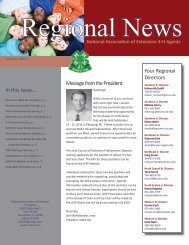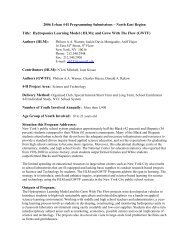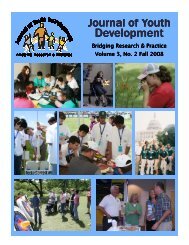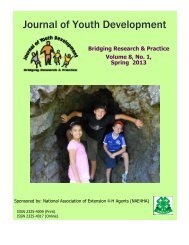Winter 2008 - Vol. 3 No. 3 - National Association of Extension 4-H ...
Winter 2008 - Vol. 3 No. 3 - National Association of Extension 4-H ...
Winter 2008 - Vol. 3 No. 3 - National Association of Extension 4-H ...
- No tags were found...
Create successful ePaper yourself
Turn your PDF publications into a flip-book with our unique Google optimized e-Paper software.
• eating diets high in fat and sugar,• watching many hours <strong>of</strong> television,• being <strong>of</strong> African American, Hispanic American, or Native American descent, and• coming from smaller or poor families (Green & Krueter, 1991).We know that television, computer and video games contribute to children's inactive lifestyles,food choices and overweight or obesity risk (Cheng, 2005; Salmon & Campbell, 2006).Evidence demonstrates that overweight and obesity in adults and their associated healthproblems have significant impacts on the health care system. A recent study focused on statelevelestimates <strong>of</strong> total, Medicare and Medicaid obesity-attributable medical expenditures.Obesity-attributable Medicaid expenditures for Michigan were estimated to be $882 million(total state level estimate was $2.9 billion) (Finkelstein, Fiebelkorn, & Wang, 2004). Michiganhas consistently ranked in the top ten states for problems <strong>of</strong> overweight, and children areincreasingly presenting with overweight-related health issues such as type 2 diabetes,hypertension and hyperlipidemia (Freedman, et al., 1999; Sinha, et al., 2002).In a recent Position Statement, the American Dietetic <strong>Association</strong> recommended communitybasedand environmental interventions as the most feasible methods to support healthfullifestyles for the greatest numbers <strong>of</strong> children and families (Ritchie, Crawford, Hoelscher, &Sothern, 2006). Our strong belief is that a well-designed public health intervention to helpchildren and families maintain a healthy weight will have meaningful impacts on the health <strong>of</strong>families. Healthy Kids, Healthy Families was developed as an innovative collaborative programthat addresses both the medical and psychosocial aspects <strong>of</strong> overweight in children. Theprogram involves direct service provision <strong>of</strong> an in-home, family-based intervention followed bymulti-family group education in the community. The program is currently being delivered by atrained MSU <strong>Extension</strong> parapr<strong>of</strong>essional in three Michigan counties.Program DescriptionThe project team consists <strong>of</strong> university researchers from the Departments <strong>of</strong> Food Science &Human Nutrition and Family & Child Ecology. The team is currently working with MSU<strong>Extension</strong> and the medical community in three Michigan Counties to <strong>of</strong>fer and evaluate theimpact <strong>of</strong> the Healthy Kids, Healthy Families program. Additional connections for programreferrals have been made with public schools and child protective services in these counties.Each <strong>of</strong> the three counties was targeted for the public health intervention because <strong>of</strong> thegrowing needs in those communities. For example, Medicaid cases for those less than 18 years<strong>of</strong> age in two <strong>of</strong> the selected counties is over 35 percent (compared with 25 percent statewide)and the median household income in one selected county is at $35,363 (compared to a stateaverage <strong>of</strong> $44,667).The curriculum was developed to address health, nutrition, cognition, and cultural and familydynamics aspects <strong>of</strong> childhood overweight. A series <strong>of</strong> six multi-family group and four in-homefamily sessions for families with overweight children were developed. These sessions providebasic nutrition and health information, and serve as a support for participants and their familiesfor effective lifestyle changes. The sessions include information about goal setting and behaviorchange as well as practical and application skills, while facilitating community connection, familystructure, and group support.The model for collaboration between clinical and community programs developed by theresearch team was invested in positive change for those participating in Healthy Kids, Healthy






